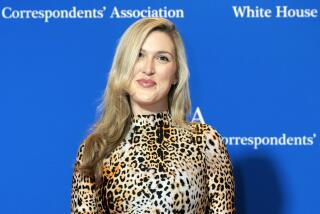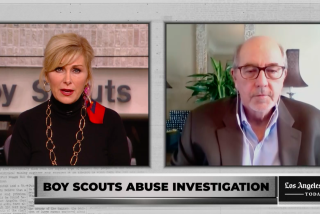Anna and the Boys of the N.Y. Times
What a relief for all the guilt-plagued, overworked mothers in the land. New York Times Op-Ed columnist Anna Quindlen will walk away from one of the most coveted jobs in American journalism at the end of the year not to spend more time with her three children as some have written, but because--and only because--she wants to write fiction full-time.
“I’m changing jobs,” says the woman who has won a Pulitzer Prize, written two novels and been named one of the outstanding mothers in America. “But that doesn’t mean I am still not going to be working really hard. . . . Hey, I can’t spend any more time than I spend with my kids now or else I’d kill ‘em.”
Whew.
*
For most of her 17-year tenure at the New York Times, Quindlen, 42, has followed a singular and stellar career path. Her special status, she acknowledges, speaks to a narrow view on the part of her employer.
She is the only woman to currently own a place on the boys-clubbish Op-Ed page, and the only woman whose name has surfaced in discussions about the line of succession for top editor jobs there, even though she has not held a management position for a decade.
“It’s the way it works everyplace,” says Quindlen, in town last week to promote her new novel, “One True Thing.”
“I’m ‘the girl.’ One time, I was at an editor’s conference and an editor (at another paper) said to me, ‘I’d love to run your column, but we already run Ellen Goodman.’ ”
It’s hard to imagine an editor saying to Dave Barry or Mike Royko or the late Lewis Grizzard: “Sorry, we can’t use you, we already run Russell Baker.” Or to William Safire and George Will: “Your services will not be needed because we already run Patrick Buchanan.”
In practical terms, this means that if an abortion doctor gets shot the same week a judge hands down an appallingly light sentence to a man who has killed his cheatin’ wife, and/or Hillary Clinton says something particularly unexpected, “the girl” faces a dilemma: She can be reasonably certain her male colleagues will not be moved to comment, and reasonably certain her readers will want to hear what she has to say on all three topics.
“You’re like, ‘Hey, somebody’s gotta take up the slack here, boys and girls,’ but nobody does,” says Quindlen. “You look at Op-Ed pages and in general, they have one woman, one person of color, and eight white guys. I don’t want to get into quotas, because I dream of a day when all the people on the Op-Ed page are women, but people get real comfortable with a ‘one-fer’ approach. So-and-so is black and so-and-so is our woman and there’s all the rest.”
In her case, being “the girl” has worked to her advantage tremendously. She was a fast-rising editor when she took a six-month maternity leave after the birth of her first son, now 11.
Eighteen months later, she had her second son, now 9, and quit the paper altogether. But then-Executive Editor A.M. Rosenthal asked her to write a free-lance column that would be about “what I was talking to my friends about on the telephone.” That column was “Life in the 30s,” about the quotidian concerns of a mom and wife (Quindlen’s husband, Gerald Krovatin, is a defense attorney). It was an astonishing departure for the staid, nearly anti-first person New York Times.
It is perhaps a measure of the New York Times’ editorial egocentricity that Quindlen’s “Life in the 30s,” which ran from 1986 to 1988, has often been described as a groundbreaking journalistic exercise, but, in fact, columnists at newspapers all over the country had been mining their families for material for years, decades even. (Think, for instance, of our own Jack Smith.)
Quindlen abandoned that column after her daughter, now 5, was born, but was lured back to the paper in 1990 with the prized spot on the Op-Ed page. Her column, “Public & Private,” gave heart to a page that was virtually all brain and won her the Pulitzer Prize in 1992.
*
Because she has been the most visible woman at one of the most visible and prestigious newspapers in the country, there has always been a sense--however exaggerated--that what Quindlen does has repercussions across the journalistic landscape.
As a result, her latest move has, perhaps unfairly, inspired all sorts of gloomy commentary on What This Means for Journalism.
In some quarters, speculation has centered on the notion that her resignation represents a failure of efforts--hers and others--to humanize the cutthroat, male-dominated work environment of the New York Times. She talks often, for instance, about “happiness as a management principle,” and indeed gave a speech on that topic last week to a meeting of magazine publishers in Orange County.
“The fact that Quindlen would rather be writing fiction than struggling to change the New York Times is a potent statement about the clash of values ripping journalism apart,” wrote New York magazine media critic Jon Katz.
“That piece made me really uncomfortable because it was really overreaching,” Quindlen says. “When he talked about how they could have done something to keep me, and what did it mean if they couldn’t hold on to me. The fact of the matter is the first salvo in the conversation with the publisher was, ‘Is there anything we can do?’ and my answer was, no, I have something entirely different that I want to do.”
Still, she says, she gets the feeling readers think she is “letting down ‘the side’--that I am liberal in an increasingly conservative time, that I am feminist in an anti-feminist time. Abortion and gay rights activists, I think, are sorry to see me go.”
So, too, are her bosses.
“It will be hard to imagine the Op-Ed page without her,” said New York Times Publisher Arthur Sulzberger Jr. in a statement last month announcing her decision to leave.
“They were pretty knocked out by the whole thing,” says Quindlen. “I mean, people don’t leave. But I always feel the best way you can be valuable to an institution is to be ready to leave at any time. It means you are willing to take chances that people who are really invested in staying there the rest of their life won’t take.”
Her most famous column, which ran in 1991, is a case in point. In it, she criticized the New York Times for naming the woman who had accused William Kennedy Smith of rape in a profile that drew heavy criticism for its portrayal of his accuser. (Smith was acquitted.)
“My publisher reads my column when it appears in print,” Quindlen says. “And I remember thinking, ‘The worst thing they can do is fire me, and I can live with that.’ If you’re always ready for that, you can take those kinds of wild chances. But if you become that kind of entrenched company person, you never will. They will say, you know, so-and-so is the perfect Timesman. Well, I was never going to be the perfect Timesman.”
No, she could be virtually anything she wanted to be at that newspaper, but never the perfect Timesman.
And isn’t it strange? You never hear about the perfect Timeswoman.
After all these years and so much progress, there isn’t any such thing.
More to Read
Sign up for our Book Club newsletter
Get the latest news, events and more from the Los Angeles Times Book Club, and help us get L.A. reading and talking.
You may occasionally receive promotional content from the Los Angeles Times.







